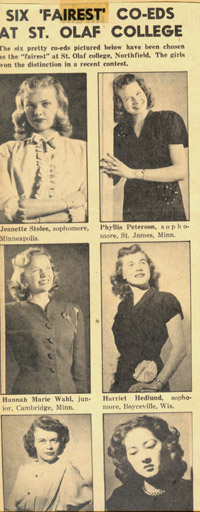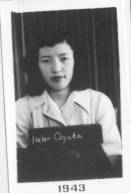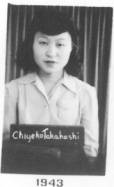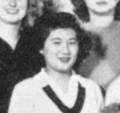Jeff Sauve Assoc. College Archivist Shaw-Olson Center for College History
“We were assigned numbers, herded into a troop train and shipped to a place a few hours away. That evening we arrived at a relocation camp in the Mojave Desert.
“For two years, tarpaper barracks with loosely constructed floors were the only home and straw-filled bags covered with blankets the only beds for about 10,000 Japanese-Americans crowded into one square mile, surrounded by barbed wire fences and sentry towers”
–Yoshiteru “Yosh” Murakami, class of 1951
Yosh’s story tells of a sad chapter in the United States history, a forgotten chapter in St. Olaf’s history-the internment of thousands of Japanese-American citizens following the attack on Pearl Harbor. I became aware recently of the College’s role in assisting those who were forced to abandon their studies when war was declared.
 While archiving a recently donated scrapbook from Thora Phelps ’47, a yellowed photo clipping titled “Six Fairest Co-eds at St. Olaf College” intrigued me. In the lower right corner is a thumbnail photo of Helen Kinoshita. I was struck by her inclusion because the clipping was from 1946, when World War II was fresh in everyone’s mind.
While archiving a recently donated scrapbook from Thora Phelps ’47, a yellowed photo clipping titled “Six Fairest Co-eds at St. Olaf College” intrigued me. In the lower right corner is a thumbnail photo of Helen Kinoshita. I was struck by her inclusion because the clipping was from 1946, when World War II was fresh in everyone’s mind.
In search of archival material related to Kinoshita, I located two small folders in the College Archives labeled, “Japanese Student Relocation.” A few scant pages in these folders tell a story worth retelling.
After the attack upon Pearl Harbor (Dec. 7, 1941), the United States government decreed in February 1942 that more than 120,000 Japanese Americans must be removed from their homes on the West Coast and relocated to ten hastily built internment camps.
A few months later, on June 17, 1942, St. Olaf’s President Lars Boe received a letter from the National Japanese American Student Relocation Council. The letter states that The War Relocation Authority was anxious to see that Japanese-American citizens be able to complete their educational studies, “in preparation for useful service and fuller assimilation into our national life.”
Two months later on Aug. 24th, Acting President J. Jorgen Thompson [Boe was rather ill and resting at home. He passed away in Dec. 1942] received a letter from a group of Lutheran Twin City students who stated the plight of Japanese students. The letter said, “As you know, most universities have pursued the policy of the Univ. of Minnesota in denying admissions to Japanese-American students.” The letter most likely settled the question for Thompson as he followed up with a letter, dated Aug. 27, to Rev. Fredrik Schiotz ’24 who served as Executive Secretary for the Student Service Department of the American Lutheran Conference:
“This morning I called a meeting of the administrative officers to discuss the position of St. Olaf College in relation to Japanese-American students. It was unanimously decided that American citizens of Japanese origin will be given the same opportunities as all other students at St. Olaf College.”
Rev. Schiotz responded on Sept. 2:
“Your letter of August 27 renewed my gratefulness in being an alumnus of St. Olaf College. Thus far, St. Olaf College is the first of the NLCA [Norwegian Lutheran Church of America] institutions of higher learning to offer the privilege of matriculation to Nisei [ second generation Japanese-Americans ] students.”
With the wheels in motion, provisions were made for several Japanese-American students to enroll. The National Student Relocation Council requested statements from the mayor of Northfield and St. John’s Church pastor giving assurance of community acceptance of the students. Thompson sounded out representative students and did not sense any negative feeling developing toward the first anticipated Japanese-American students enrolling.
Due to the endless amount of paperwork, travel permits, and FBI investigations needed to “relocate” a student from an internment camp, the first three students did not arrive until late January and early February of 1943.
From the spring of 1943 until the fall of 1944, a total of 10 Japanese-American students, representing 7 of the 10 relocation camps, enrolled in St. Olaf College. These brave students left their families behind in relocation camps such as Heart Mountain, Wyoming; Granada, Colorado; Manzaner, California; and Gila River, Arizona. The College Catalog listed the hometown of each student as his or her former internment camp address. The Manitou Messenger and the Alumni Magazine both neglected–perhaps discreetly so–to ever cover the influx of new students.
The majority of the Japanese-American students remained at St. Olaf for a semester or two; however two students completed their studies, Helen Kinoshita and Yoshiteru “Yosh” Murakami, graduated in 1947 and 1951, respectively. Incidentally, both Helen and Yosh were members of the St. Olaf Choir-the first ever students of color in the Choir.
“Yosh,” as he was affectionately called by his classmates, would later tell of his time behind barbed wire at the Mohave Desert Relocation Camp (Manzaner) and his subsequent enrollment in St. Olaf College, which offered a strong music curriculum.
For the most part, Yosh resided in Northfield for the remainder of his life. He served for many years as the Choir Director of Northfield High School. He and his wife Mikiko raised a family of four talented children. Yosh served in the U.S. military as a Japanese interpreter from 1946-1948, returning to St. Olaf to complete his degree in public school music. Yosh passed away in 1975 after a short and severe illness. St. Olaf classmates as well as citizens and former students of Northfield fondly remember him.
The other nine Japanese American students have fallen off the archives’ radar. Only fragmentary notes have been located, and their whereabouts and life vocations are unknown.
*If you have any information on these students that you would like to share, please contact Jeff Sauve (sauve@stolaf.edu ) or call 507-646-3229.
| Photo (if available) | Date of enrollment | Student Name |
| No picture | Feb. 8, 1944 | Mary Harve Hayano |
 |
Jan. 31, 1944 | Helen Kinoshita |
| No picture | Jan. 30, 1943 | Mayme Shizuyo Kishi |
 |
Sept. 12, 1944 | Yoshiteru “Yosh” Murakami |
 |
Sept. 12, 1944 | Esther Fukiye Nagao |
 |
Sept. 14, 1943 | Helen Haruyo Ogata |
| No picture | Listed in catalog sem. 2 1944 (no transcript file) | Miye Helen Oshima |
 |
Sept. 14, 1943 | Chiyeko Takahashi |
 |
Jan. 29, 1944 | Yuki Takei |
 |
Jan. 29, 1944 | Elaine Yoshino Uyemura |